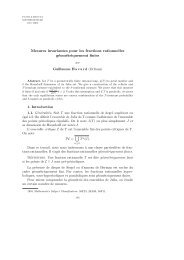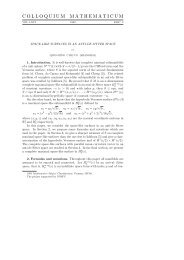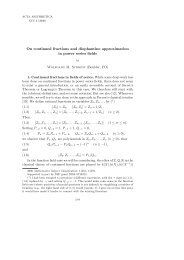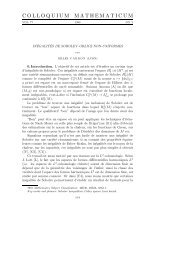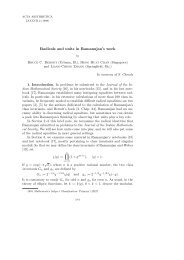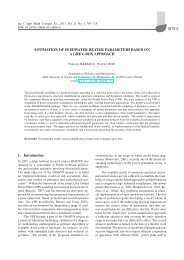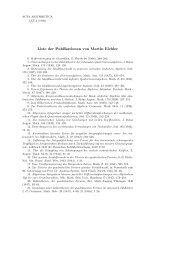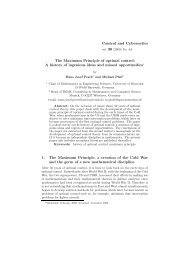DP2PN2Solver: A flexible dynamic programming solver software tool
DP2PN2Solver: A flexible dynamic programming solver software tool
DP2PN2Solver: A flexible dynamic programming solver software tool
Create successful ePaper yourself
Turn your PDF publications into a flip-book with our unique Google optimized e-Paper software.
694 H. MAUCH<br />
4.2. The traveling salesman problem (TSP) example<br />
Given a complete weighted directed graph G = (V, E) with distance matrix<br />
C = (ci,j) the optimization version of the traveling saleman problem asks to<br />
find a minimal Hamiltonian cycle (visiting each of the n = |V | vertices exactly<br />
once). Without loss of generality assume V = {0, . . ., n−1}. The DP functional<br />
equation can be expressed as<br />
f(v, S) =<br />
� min<br />
d/∈S {f(d, S ∪ {d}) + cv,d} if |S| < n<br />
cv,s<br />
if |S| = n<br />
where the length of the minimal cycle is computed as f(s, {s}), with s ∈ V .<br />
(The choice of the starting vertex s is irrelevant, since we are looking for a<br />
cycle, so arbitrarily pick s = 0.) In the above DP functional equation (2), a<br />
state is a pair (v, S) where v can be interpreted as the current vertex and S as<br />
the set of vertices already visited.<br />
For instance, let<br />
⎛<br />
⎜<br />
C = ⎜<br />
⎝<br />
0 1 8 9 60<br />
2 0 12 3 50<br />
7 11 0 6 14<br />
10 4 5 0 15<br />
61 51 13 16 0<br />
⎞<br />
⎟<br />
⎠ .<br />
Apply the DP functional equation (2) to compute f(0, {0}) = 39. By keeping<br />
track of which arguments minimize the min-expressions in each case, we find<br />
that the minimal cycle is (0, 1, 3, 4, 2).<br />
Note the convenient use of variables and literals of the type Set in the<br />
following gDPS example for this problem instance.<br />
BEGIN<br />
NAME TSP; //TravelingSalesmanProblem;<br />
GENERAL_VARIABLES_BEGIN<br />
//adjacency matrix for TSP.<br />
private static int[][] distance =<br />
{<br />
{ 0, 1, 8, 9, 60},<br />
{ 2, 0, 12, 3, 50},<br />
{ 7, 11, 0, 6, 14},<br />
{10, 4, 5, 0, 15},<br />
{61, 51, 13, 16, 0}<br />
};<br />
private static int n = distance.length;<br />
//number of nodes n=5. Nodes are named starting<br />
//at index 0 through n-1.<br />
(2)



